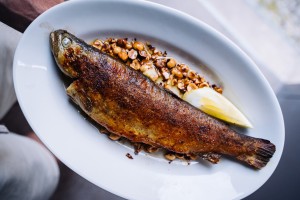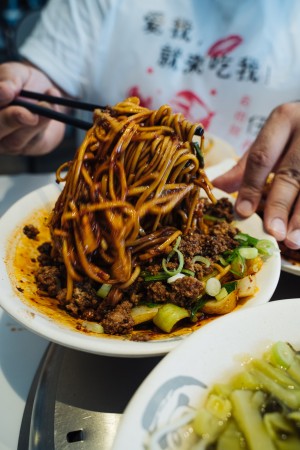Name for me a truly outstanding, German restaurant in Berlin. Go on, I challenge you. Give it a go.
But, before you answer, consider these simple criteria:
1. The restaurant has to focus on traditional German food.
2. The ingredients have to be of exceptional quality and
3. The level of cooking has to be on the highest level, using no shortcuts, cooking everything from scratch. Think classical, French Brasserie or Italian Trattoria. Iconic restaurants with a decades-long devotion to quality.
Struggling to find a good answer? That’s ok, you're not alone.
Locating truly outstanding German restaurants in Berlin has always been a culinary conundrum. Even though I've been writing about the city's dining scene for over a decade, it's downright baffling (and frustrating) that I can't effortlessly rattle off at least five fantastic German eateries. When folks inquire about the best German restaurants in Berlin, my responses usually lead to long-winded explanations about how Berlin hasn't historically been a hotbed for exceptional German cuisine. You see, Berlin's turbulent history, marked by wars and division, hasn't left much room for gastronomic greatness. As a result, Berliners tend to stick to non-German fare, and maybe, just maybe, you should too. How about Turkish Kebap? Neapolitan Pizza? Sichuan Chinese? Northern Thai? I've got a plethora of options for you. But when it comes to German food, especially the Northern variety, I'm often left drawing a blank and the person asking has long forgotten their query due to their rumbling stomach.
“ Locating truly outstanding German restaurants in Berlin has always been a culinary conundrum.
My Instagram interview series, #BFSEATLIKEACHEF, in which I pick the brains of Berlin's top hospitality professionals for their restaurant recommendations, confirms that I'm not the only one grappling with this dilemma. Nearly everyone I've asked struggles to name a standout German restaurant, and, when someone does manage to come up with an answer, it's often Austrian cuisine they're (mistakenly) touting. This underscores my point perfectly; if you're craving Austrian dishes, you've got some great options. You can savor a cozy dinner at Alt Wien, take it up a notch at the more elevated Jolesch, or revel in hospitality perfection at Einstein Unter den Linden. But, there's a marked difference between Austrian and German cuisine, especially from a cultural perspective. We're talking about dishes like Königsberger Klopse and Eisbein, as opposed to Schnitzel and Tafelspitz, important distinctions that demand attention - we're in perilous waters where details matter.
Now, don't get me wrong; there are a handful of good German restaurants in Berlin. However, they're more like rare gems in a sea of mediocrity and downright awful dining establishments. I absolutely adore the fantastic lunches at Lebensmittel in Mitte (seriously, why is lunch so much better than dinner there?). I've spent countless summer nights enjoying the atmosphere in the Prater Biergarten Restaurant (note that I said Restaurant; the food at the actual Biergarten is another story entirely). The Schinkenhaxe at zur Haxe is a pork lover's dream, a crunchy, crispy, porky paradise. And, I can't help but reminisce about the delightful lunches at Imbiss 204 on Prenzlauer Allee and the Königsberger Klopse at Tim Raue's La Soupe Populaire. But, unfortunately, these are the exceptions, not the rule. Most other German restaurants either fall into the "cheap" category, where they compromise on quality to cater to the value-for-money crowd (Preis-Leistungs-Verhältnis ÜBER ALLES!), or they venture too far into the "German tapas" or "German classics with a twist" territory, often adding random Asian ingredients (wasabi!) or fruits that have absolutely no business near that plate.
“ However, the complete absence of culinary evolution in the 2000s is glaringly obvious.
The real issue here, I believe, is the lack of progress. It's understandable that Berlin's dining scene needed a moment to catch its breath after the fall of the Berlin Wall. However, the complete absence of culinary evolution in the 2000s is glaringly obvious. While Berlin's food landscape as a whole has seen exponential growth in recent years (hello; pizza, burgers, bistros, and more), German restaurants have been stuck in a time warp. Sure, the "fine-dining-modern-German" sector saw some action, with restaurants like Nobelhart & Schmutzig, Rutz, and Otto making their marks on the scene. However, one could argue that these establishments merely put a German spin on the new Nordic cuisine trend.
“ I have to be honest, after more than a decade of waiting, I had almost given up hope for any significant change.
Even something so quintessentially German as the art of bread baking saw its quality revolutionized by expats, not native Germans. You'd think Germans had the upper hand in this department, but nope. It took an expat, namely Alfredo Sironi, to catapult Berlin into a new era for artisanal sourdough baking (way) back in 2013. Two years later, a German, Florian Domberger, joined the battle for exceptional bread and tackled the challenge of perfecting German sourdough Brezeln. A telling example of this transformation is Nobelhart, which initially served Italian Sironi bread made with local rye, only later switched to the German Domberger (their current bread provider).
I have to be honest, after more than a decade of waiting, I had almost given up hope for any significant change. But then, all of a sudden, just as it's happened so many times before, the winds of change swept through the culinary halls of this city. First, the Otto team unveiled their casual German restaurant, Trio, demonstrating how a modern German eatery can look and operate and how excellent classical Gasthaus-cuisine can really be. Then, Jessica Joyce-Sidon (formerly of Baldon) and Alex Strodel proved to us that the food at a Biergarten by the Spree can be truly great at their Eierhäuschen project in Treptower Park (the cover photo is from their indoor soft opening). Micha Schäfer from Nobelhart & Schmutzig contributed a verse with a sublime version of the German Stulle (the classic German closed sandwich) with his collaboration at Keit in Friedrichshain. And then, just like that, even Tim Raue started offering a menu that's not Asian-inspired, and I found myself devouring Hühnerfrikassee, Klopse, and Gulasch instead of Peking Duck and Wasabi Langoustines at his flagship two Michelin starred restaurant.
“ While it's still early days, it's safe to say that the tide is turning.
There must be something in the air - maybe a sense of culinary nostalgia that has caught the attention of forward-thinking chefs. Maybe it's a creative reaction to the current zeitgeitst. Both from the consumer side and from within kitchens, there is a consensus that this might be the time to tackle the topic of Berlin’s culinary identity - while it's still early days, it's safe to say that the tide is turning.
Stay tuned here as we’ll be closely covering the development of this seismic change to make sure you too are informed. For me, I already know that I have much better answers now when someone asks me, "What's the best German restaurant in Berlin?"








